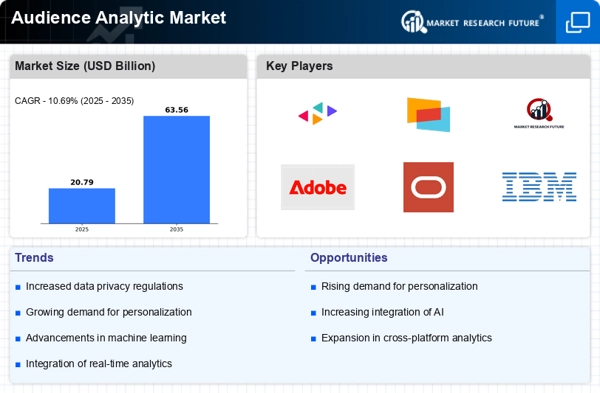Rise of Social Media Influence
The Audience Analytic Market Industry is significantly impacted by the rise of social media platforms as key channels for audience engagement. With billions of users actively participating in social networks, businesses are increasingly turning to audience analytics to gauge sentiment, preferences, and trends. Data indicates that over 70% of marketers consider social media analytics essential for understanding their audience. This shift towards social media-driven insights enables companies to craft more effective marketing strategies, aligning their messaging with audience expectations. Furthermore, the ability to track engagement metrics across various platforms allows organizations to optimize their campaigns in real-time, enhancing overall effectiveness. As social media continues to evolve, its influence on audience behavior and preferences will likely drive further investment in the Audience Analytic Market Industry.
Growing Demand for Personalization
The Audience Analytic Market Industry experiences a notable surge in demand for personalized content and experiences. As consumers increasingly expect tailored interactions, businesses are compelled to leverage audience analytics to understand preferences and behaviors. This trend is evidenced by a reported increase in customer engagement rates, with personalized marketing campaigns yielding up to 20% higher conversion rates. Companies that utilize audience analytics effectively can create targeted strategies that resonate with specific demographics, thereby enhancing customer loyalty and satisfaction. The ability to analyze vast amounts of data allows organizations to refine their offerings, ensuring they meet the evolving needs of their audience. Consequently, the growing demand for personalization serves as a critical driver in the Audience Analytic Market Industry, pushing firms to invest in advanced analytics tools and technologies.
Increased Focus on Customer Experience
The Audience Analytic Market Industry is witnessing an increased focus on enhancing customer experience as a primary business objective. Companies recognize that a positive customer experience is crucial for retention and brand loyalty. By utilizing audience analytics, organizations can identify pain points and areas for improvement in the customer journey. Data shows that businesses prioritizing customer experience can achieve up to 60% higher profits compared to their competitors. This emphasis on customer-centric strategies drives the demand for analytics tools that provide actionable insights into audience behavior. As organizations strive to create seamless and enjoyable experiences, the role of audience analytics becomes indispensable. Consequently, the increased focus on customer experience acts as a significant driver in the Audience Analytic Market Industry, compelling businesses to adopt more sophisticated analytical approaches.
Regulatory Compliance and Data Governance
The Audience Analytic Market Industry is increasingly influenced by the need for regulatory compliance and robust data governance frameworks. As data privacy regulations become more stringent, organizations must ensure that their audience analytics practices adhere to legal standards. This necessity drives the demand for analytics solutions that incorporate compliance features, enabling businesses to manage data responsibly. Reports indicate that companies investing in data governance can reduce compliance-related costs by up to 25%. Furthermore, effective data governance enhances consumer trust, which is vital for long-term success in the Audience Analytic Market Industry. As organizations navigate the complexities of regulatory requirements, the focus on compliance and governance will likely continue to shape the landscape of audience analytics, prompting investments in secure and compliant analytics solutions.
Advancements in Data Collection Technologies
Technological advancements in data collection methods are reshaping the Audience Analytic Market Industry. Innovations such as IoT devices, mobile applications, and advanced tracking software enable businesses to gather comprehensive data on consumer behavior. This influx of data provides organizations with deeper insights into audience preferences and trends, facilitating more informed decision-making. Reports suggest that companies utilizing advanced data collection techniques can improve their marketing ROI by up to 30%. As the volume of data continues to grow, the need for sophisticated analytics tools becomes increasingly apparent. Organizations that invest in these technologies are better positioned to understand their audience, leading to more effective marketing strategies. Thus, advancements in data collection technologies serve as a pivotal driver in the Audience Analytic Market Industry, fostering a more data-driven approach to audience engagement.


















Leave a Comment